A Lightweight and Low-Power UAV-Borne Ground Penetrating Radar Design for Landmine Detection
Abstract
:1. Introduction
2. Stepped Frequency Continuous Wave Radar
2.1. Principle of Working
2.2. Sfcw Radar Advantages
3. Sfcw Radar Design
3.1. Air-Launched Gpr Antenna
3.2. Transmitter Design
3.3. Digital Processing Block and Rf Front-End Design
- The RF front-end input is coupled with the RX antenna.
- The IQ base-band signal is acquired, serving as the receiver IQ base-band data .
- The RF front-end input is directly coupled with the TX channel.
- The IQ base-band signal is acquired, serving as the reference IQ base-band data .
4. Hardware Overview
4.1. Uav Overview
4.2. Sfcw Gpr Overview
5. Experimental Results
5.1. Laboratory Experimental Tests
5.2. Field Measurements with Use of An Uav
5.3. Performance Comparison between Other Systems
- The SFCW GPR system: Inhomogeneous soil that contains smaller stones and is covered by grass, where test landmines have been buried down to 20 cm.
- System 1: tests have included AT and AP landmines, which are located above the ground surface on an outdoor polygon.
- System 2: tests have included corner reflectors with different Radar Cross Sections (RCS), metal cans and plastic boxes, which are located above the ground surface on an outdoor polygon.
- System 3: on-ground tests have been performed in sandy soil, where a metallic disk was buried down to 15 cm. In-flight tests have included a sandbox, where a metallic disk was buried down to 12 cm. The sandbox was covered with a canvas.
6. Conclusions
Author Contributions
Funding
Conflicts of Interest
References
- International Campaign to Ban Landmines, Landmine Monitor 2019. Available online: http://www.the-monitor.org (accessed on 10 February 2020).
- Won, I.; Keiswetter, D.; Bell, T. Electromagnetic induction spectroscopy for clearing landmines. IEEE Trans. Geosci. Remote Sens. 2001, 39, 703–709. [Google Scholar] [CrossRef]
- Jol, H.M. Ground Penetrating Radar Theory and Applications; Elsevier: Amsterdam, The Netherlands, 2009; pp. 179–508. [Google Scholar]
- King, C. Jane’s: Mines and Mine Clearance 2011–2012, 16th ed.; IHS Jane’s: Coulsdon, UK, 2011; pp. 100–101. [Google Scholar]
- Sato, M.; Feng, X.; Fujiwara, J. Handheld GPR and MD sensor for landmine detection. In Proceedings of the 2005 IEEE Antennas and Propagation Society International Symposium, Washington, DC, USA, 3–8 July 2005. [Google Scholar] [CrossRef]
- Garcia-Fernandez, M.; Morgenthaler, A.; Alvarez-Lopez, Y.; Heras, F.L.; Rappaport, C. Bistatic Landmine and IED Detection Combining Vehicle and Drone Mounted GPR Sensors. Remote Sens. 2019, 11, 2299. [Google Scholar] [CrossRef] [Green Version]
- Webb, A.; Havens, T.C.; Schulz, T.J. Spectral diversity for ground clutter mitigation in forward-looking GPR. In Detection and Sensing of Mines, Explosive Objects, and Obscured Targets XXI; Bishop, S.S., Isaacs, J.C., Eds.; SPIE: Bellingham, WA, USA, 2016. [Google Scholar] [CrossRef]
- Sipos, D.; Planinsic, P.; Gleich, D. On drone ground penetrating radar for landmine detection. In Proceedings of the 2017 First International Conference on Landmine: Detection, Clearance and Legislations (LDCL), Beirut, Lebanon, 26–28 April 2017. [Google Scholar] [CrossRef]
- Stempfhuber, W.; Buchholz, M. A precise, low-cost RTK GNSS system for UAV applications. ISPRS—Int. Arch. Photogramm. Remote. Sens. Spat. Inf. Sci. 2012, XXXVIII-1/C22, 289–293. [Google Scholar] [CrossRef] [Green Version]
- Cerquera, M.R.P.; Montaño, J.D.C.; Mondragón, I. UAV for Landmine Detection Using SDR-Based GPR Technology. In Robots Operating in Hazardous Environments; InTech: London, UK, 2017. [Google Scholar] [CrossRef] [Green Version]
- Colorado, J.; Perez, M.; Mondragon, I.; Mendez, D.; Parra, C.; Devia, C.; Martinez-Moritz, J.; Neira, L. An integrated aerial system for landmine detection: SDR-based Ground Penetrating Radar onboard an autonomous drone. Adv. Robot. 2017, 31, 791–808. [Google Scholar] [CrossRef]
- Schreiber, E.; Heinzel, A.; Peichl, M.; Engel, M.; Wiesbeck, W. Advanced Buried Object Detection by Multichannel, UAV/Drone Carried Synthetic Aperture Radar. In Proceedings of the 2019 13th European Conference on Antennas and Propagation (EuCAP), Krakow, Poland, 31 March–5 April 2019; pp. 1–5. [Google Scholar]
- Schartel, M.; Burr, R.; Mayer, W.; Docci, N.; Waldschmidt, C. UAV-Based Ground Penetrating Synthetic Aperture Radar. In Proceedings of the 2018 IEEE MTT-S International Conference on Microwaves for Intelligent Mobility (ICMIM), Munich, Germany, 15–17 April 2018; pp. 1–4. [Google Scholar]
- García Fernández, M.; Álvarez López, Y.; Arboleya Arboleya, A.; González Valdés, B.; Rodríguez Vaqueiro, Y.; Las-Heras Andrés, F.; Pino García, A. Synthetic Aperture Radar Imaging System for Landmine Detection Using a Ground Penetrating Radar on Board a Unmanned Aerial Vehicle. IEEE Access 2018, 6, 45100–45112. [Google Scholar] [CrossRef]
- Nguyen, C.; Park, J. Stepped-Frequency Radar Sensor Analysis. In Stepped-Frequency Radar Sensors; Springer GmbH: Cham, Switzerland, 2016; pp. 39–64. [Google Scholar] [CrossRef]
- Grandjean, G.; Paillou, P.; Dubois-Fernandez, P.; August-Bernex, T.; Baghdadi, N.N.; Achache, J. Subsurface structures detection by combining L-band polarimetric SAR and GPR data: Example of the Pyla Dune (France). IEEE Trans. Geosci. Remote Sens. 2001, 39, 1245–1258. [Google Scholar] [CrossRef]
- Gilmore, C.; Collins, D.; Jeffrey, I.; Peters, S.; LoVetri, J. Design, implementation and testing of a prototype 1.1-2.1 GHz SFCW GPR for use in landmine detection. In Proceedings of the IEEE CCECE2002. Canadian Conference on Electrical and Computer Engineering. Conference Proceedings (Cat. No. 02CH37373), Winnipeg, MB, Canada, 12–15 May 2002. [Google Scholar] [CrossRef]
- Vickers, R. Design and applications of airborne radars in the VHF/UHF band. IEEE Aerosp. Electron. Syst. Mag. 2002, 17, 26–29. [Google Scholar] [CrossRef]
- Comite, D.; Ahmad, F.; Amin, M.G.; Dogaru, T. Multi-aperture processing for improved target detection in forward-looking GPR applications. In Proceedings of the 2016 10th European Conference on Antennas and Propagation (EuCAP), Davos, Switzerland, 10–15 April 2016; pp. 1–3. [Google Scholar] [CrossRef]
- Fischer, C.; Wiesbeck, W. Laboratory verification for a forward-looking multi-receiver mine-detection GPR. In Proceedings of the IGARSS 2000. IEEE 2000 International Geoscience and Remote Sensing Symposium. Taking the Pulse of the Planet: The Role of Remote Sensing in Managing the Environment. Proceedings (Cat. No.00CH37120), Honolulu, HI, USA, 24–28 July 2000; Volume 4, pp. 1643–1645. [Google Scholar] [CrossRef]
- Sun, Y.; Li, J. Time–frequency analysis for plastic landmine detection via forward-looking ground penetrating radar. IEE Proc. Radar Sonar Navig. 2003, 150, 253–261. [Google Scholar] [CrossRef]
- Wang, T.; Sjahputera, O.; Keller, J.M.; Gader, P.D. Landmine detection using forward-looking GPR with object tracking. In Detection and Remediation Technologies for Mines and Minelike; Targets, X., Harmon, R.S., Broach, J.T., John, H., Holloway, J., Eds.; SPIE: Bellingham, WA, USA, 2005. [Google Scholar] [CrossRef]
- Rosen, E.M.; Ayers, E. Assessment of down-looking GPR sensors for landmine detection. In Detection and Remediation Technologies for Mines and Minelike; Targets, X., Harmon, R.S., Broach, J.T., John, H., Holloway, J., Eds.; SPIE: Bellingham, WA, USA, 2005. [Google Scholar] [CrossRef]
- Charvat, G.L. Small and Short-Range Radar Systems; CRC Press Inc.: Boca Raton, FL, USA, 2014. [Google Scholar]
- Cam Nguyen, J.H. Time-Domain Ultra-Wideband Radar, Sensor and Components; Springer GmbH: Cham, Switzerland, 2014. [Google Scholar] [CrossRef]
- Ahmed, A.; Zhang, Y.; Burns, D.; Huston, D.; Xia, T. Design of UWB Antenna for Air-Coupled Impulse Ground-Penetrating Radar. IEEE Geosci. Remote Sens. Lett. 2016, 13, 92–96. [Google Scholar] [CrossRef]
- Hirai, N.; Maeno, Y.; Tamura, H.; Kaneko, D.; Tanaka, T.; Ohki, Y.; Tajitsu, Y.; Kohtoh, M.; Okabe, S. Dielectric properties of biodegradable polylactic acid and starch ester. In Proceedings of the 2004 IEEE International Conference on Solid Dielectrics, 2004 (ICSD 2004), Toulouse, France, 5–9 July 2004; Volume 1, pp. 87–89. [Google Scholar]
- DJI Matrice 600 Pro. Available online: https://www.dji.com/si/matrice600-pro (accessed on 10 February 2020).
- PulsON 440. Available online: https://fccid.io/NUF-P440-A/User-Manual/User-Manual-2878444.pdf (accessed on 4 April 2020).

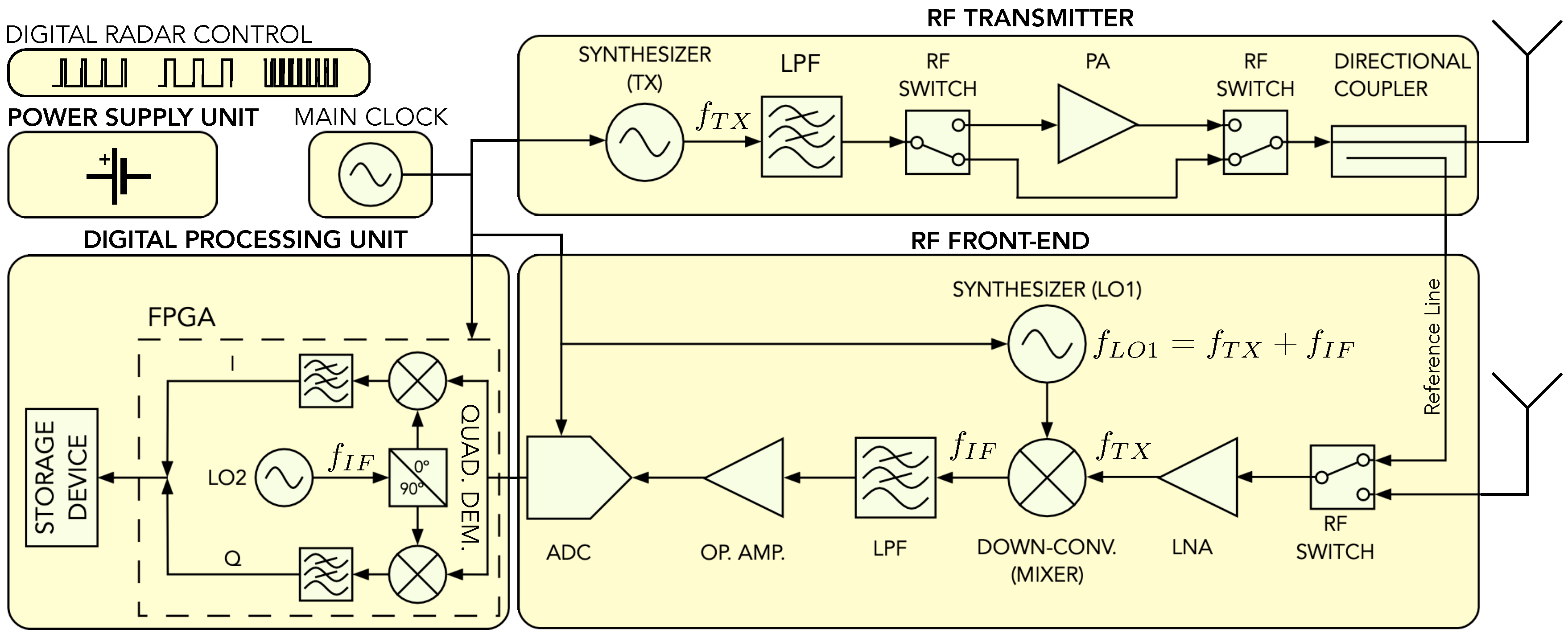

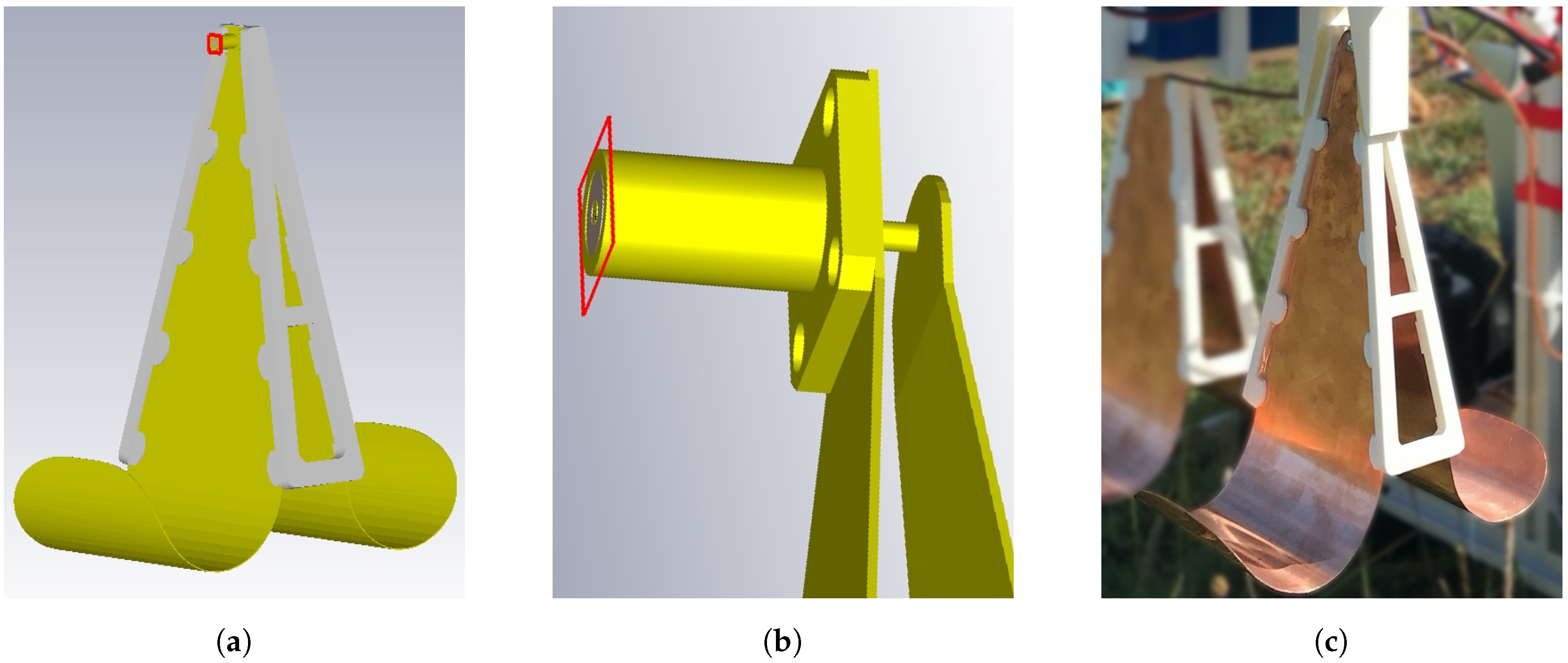

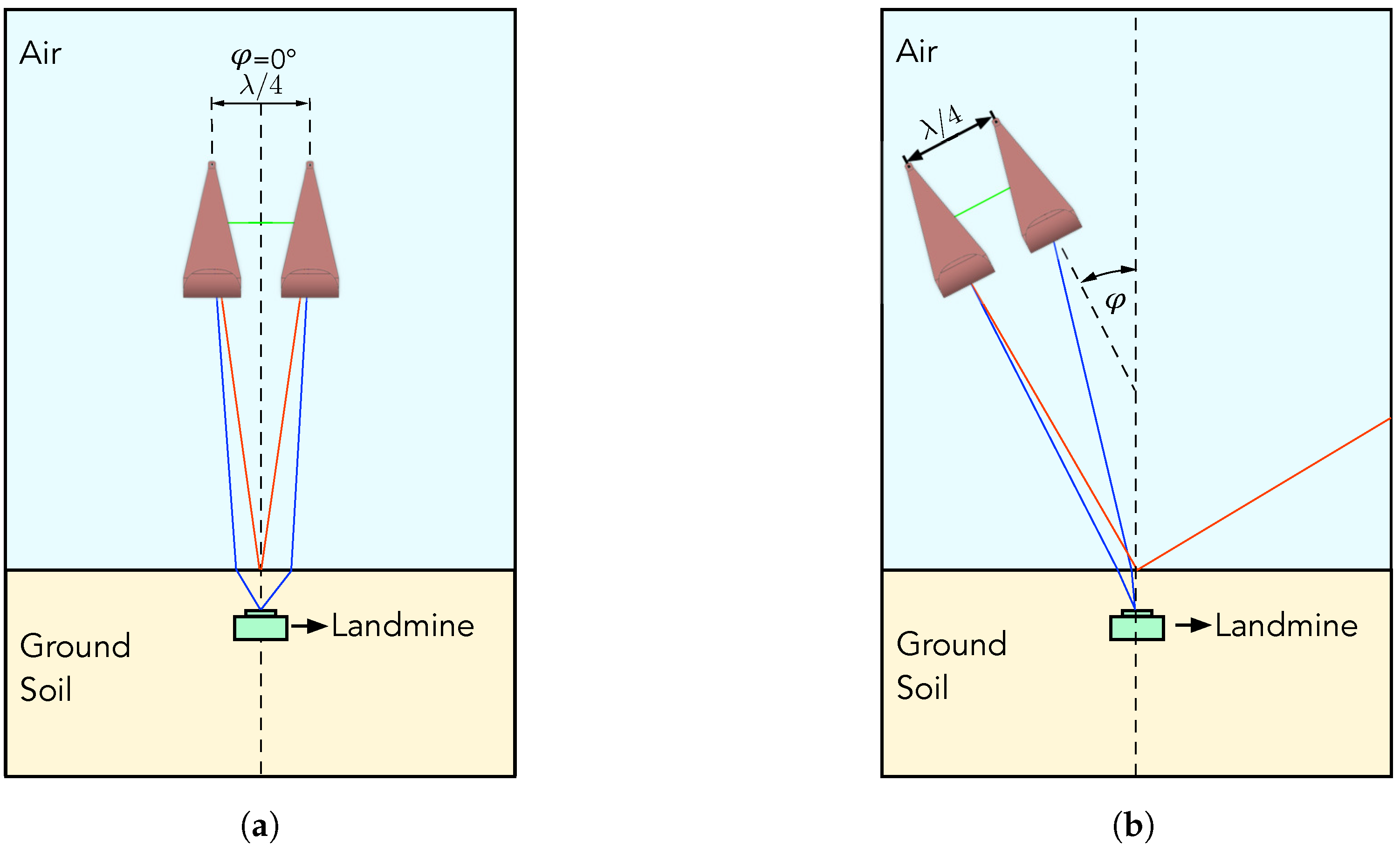





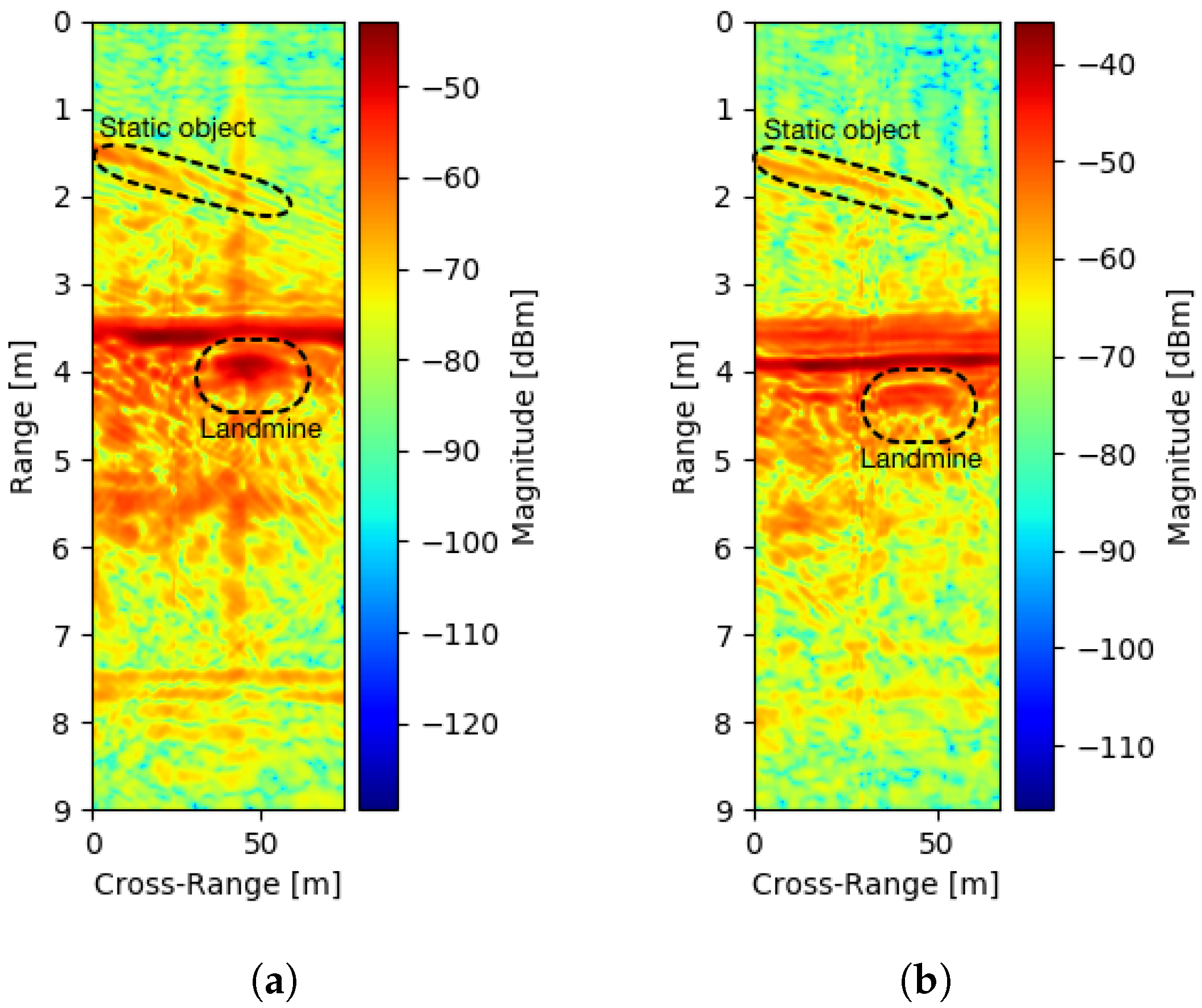
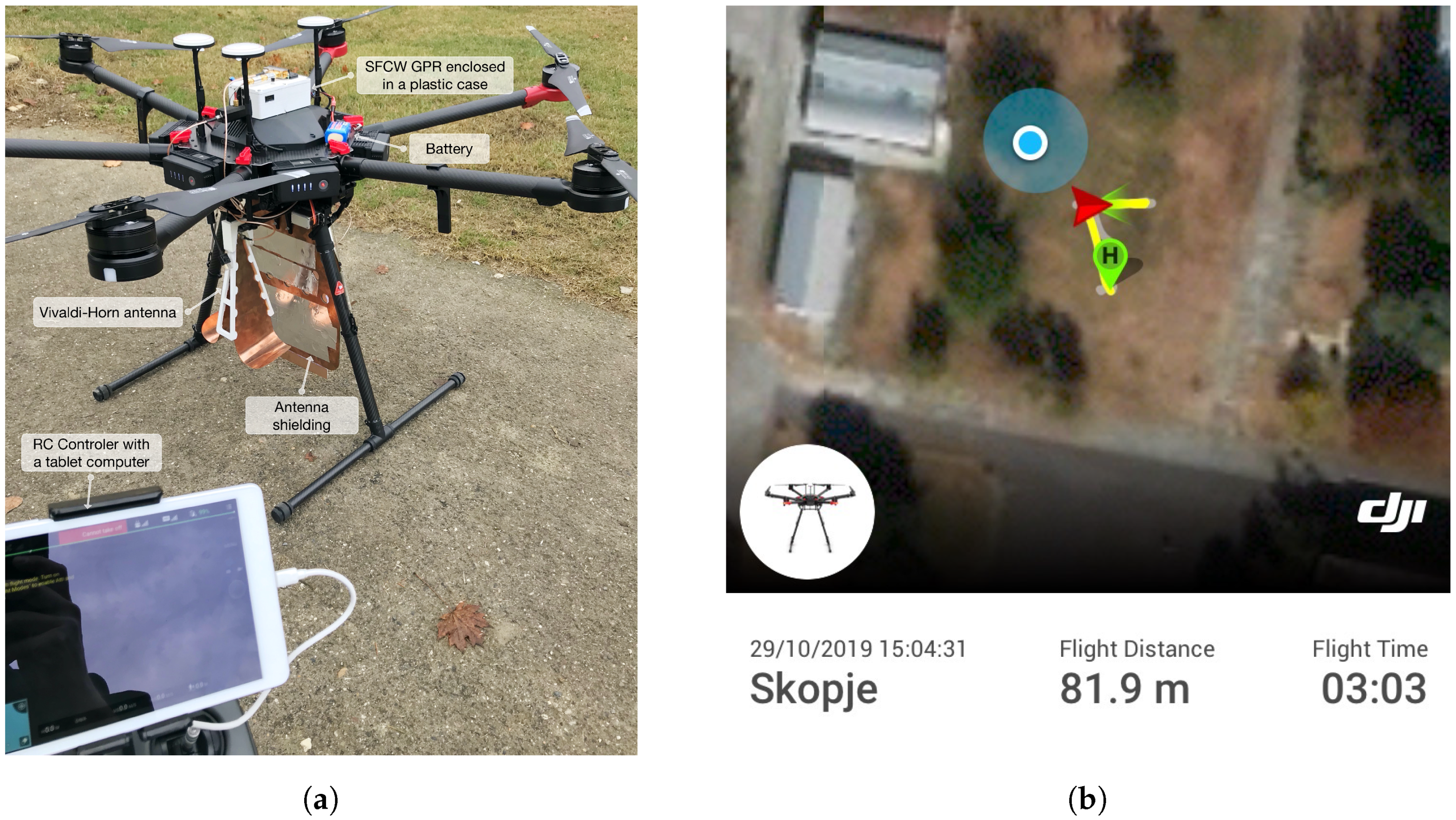
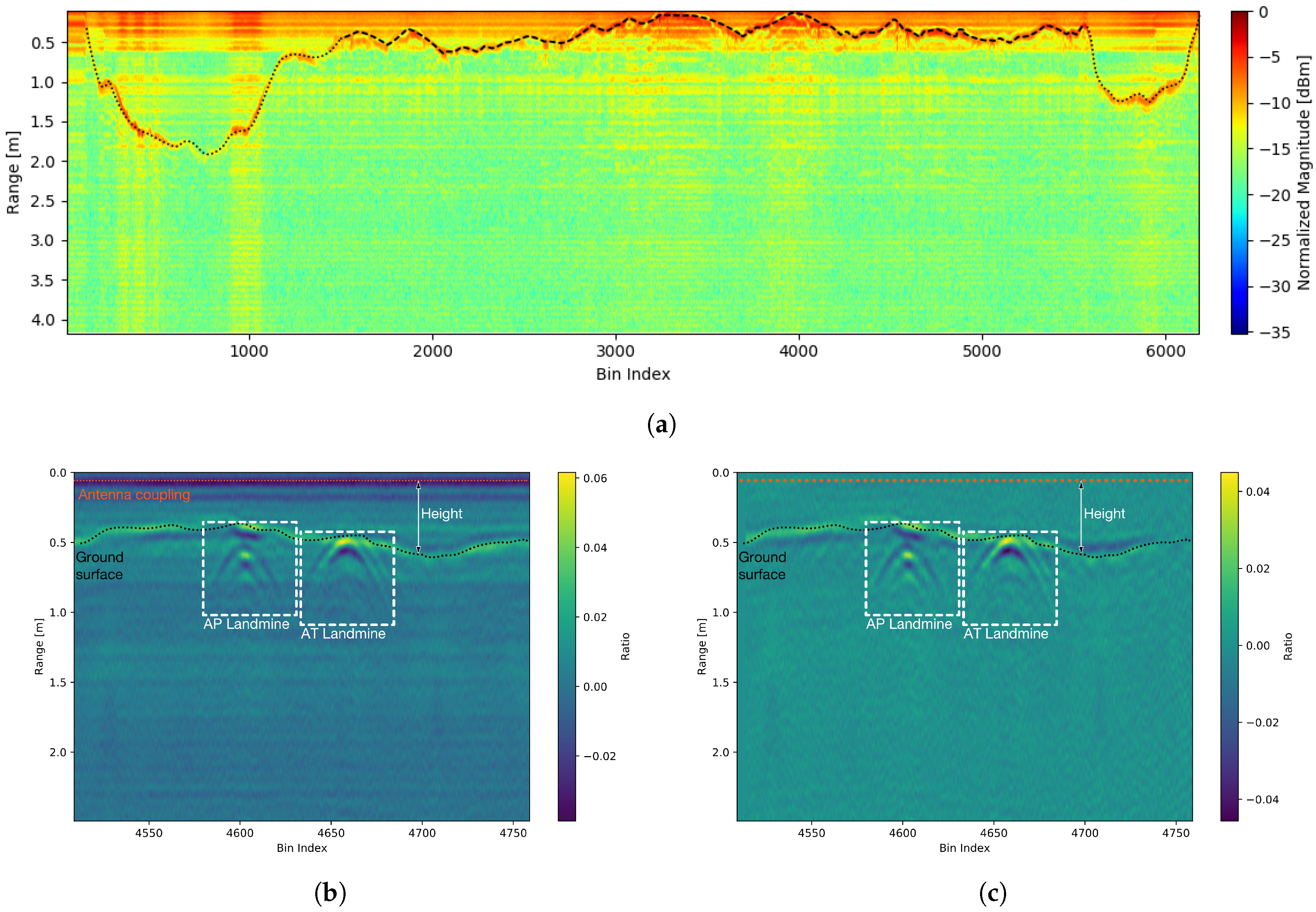
| Parameter | Value |
|---|---|
| Minimal freq. step | 40 kHz |
| Maximal num. of freq. steps | 53,750 |
| Frequency range | 550 MHz–2.7 GHz |
| TX output power | dBm |
| Power Consumption | 4.2 W |
| SFCW GPR size | 100 mm × 50 mm |
| Antenna size (1 pcs) | 95 mm × 225 mm × 180 mm |
| SFCW GPR weight | 30 g |
| Antenna weight (1 pcs) | 240 g |
| Total payload weight | 780 g |
| UAV system autonomy | 25 min |
© 2020 by the authors. Licensee MDPI, Basel, Switzerland. This article is an open access article distributed under the terms and conditions of the Creative Commons Attribution (CC BY) license (http://creativecommons.org/licenses/by/4.0/).
Share and Cite
Šipoš, D.; Gleich, D. A Lightweight and Low-Power UAV-Borne Ground Penetrating Radar Design for Landmine Detection. Sensors 2020, 20, 2234. https://doi.org/10.3390/s20082234
Šipoš D, Gleich D. A Lightweight and Low-Power UAV-Borne Ground Penetrating Radar Design for Landmine Detection. Sensors. 2020; 20(8):2234. https://doi.org/10.3390/s20082234
Chicago/Turabian StyleŠipoš, Danijel, and Dušan Gleich. 2020. "A Lightweight and Low-Power UAV-Borne Ground Penetrating Radar Design for Landmine Detection" Sensors 20, no. 8: 2234. https://doi.org/10.3390/s20082234
APA StyleŠipoš, D., & Gleich, D. (2020). A Lightweight and Low-Power UAV-Borne Ground Penetrating Radar Design for Landmine Detection. Sensors, 20(8), 2234. https://doi.org/10.3390/s20082234






